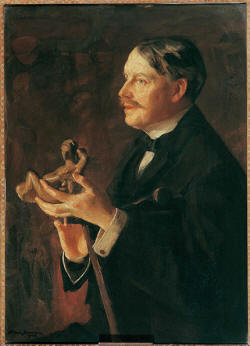

Queer Places:
Fondazione Horne, Via dei Benci, 6, 50100 Firenze FI
Cimitero Evangelico agli Allori, Florence, Italy
 Herbert Percy Horne (born 18 February 1864 in London, United Kingdom ; † 14 April 1916 in Florence) was an English poet, architect, art historian and art collector who contributed his collection of some 6,000 works of Florentine art from the 13th to the 16th century to a foundation that produced the Museo Horne in Florence.
The museum opened to the public in 1921 thanks to the work of
Carlo Gamba and
Giovanni Poggi, who had been Horne’s friends and were the first members of the Foundation. Non Delebo Propter Decem (1891) was included in Sexual Heretics: Male
Homosexuality in English Literature from 1850-1900, by Brian Reade.
Herbert Percy Horne (born 18 February 1864 in London, United Kingdom ; † 14 April 1916 in Florence) was an English poet, architect, art historian and art collector who contributed his collection of some 6,000 works of Florentine art from the 13th to the 16th century to a foundation that produced the Museo Horne in Florence.
The museum opened to the public in 1921 thanks to the work of
Carlo Gamba and
Giovanni Poggi, who had been Horne’s friends and were the first members of the Foundation. Non Delebo Propter Decem (1891) was included in Sexual Heretics: Male
Homosexuality in English Literature from 1850-1900, by Brian Reade.
Horne was a strangely versatile universal genius. [1] Born in London as the eldest son of Horace Horne and Luisa Harmale, he was a precocious child and showed his strong interest in the arts at Kensington Grammar School in London, promoted by sympathetic teachers. [2]
In the 1880s and 1890s, Simeon Solomon corresponded with one of his most important patrons, art collector and founder of the Century Guild publishing company, Herbert Horne, through notes and letters written and sent by way of the City News Room at Ludgate Circus.
In 1880 Horne got to know the writings of W. H. Pater, especially the Studies in the history of the Renaissance (1873) fascinated him. In 1882 he began working as a staff member in the architectural studio of A. H. Mackmurdo, whose partner he was between 1885 and 1890. Together with Mackmurdo, he founded the art magazine The Century Guild Hobby Horse, which was co-founded by such well-known authors as Oscar Wilde and John Ruskin. During these years he developed his graphic talent, which he used as a font designer and typographer. In the vicinity of Arts & Crafts, he dealt not only with writings, but also with all the artisanal pages of graphic design, drawing wallpapers, book covers and ex-libris. [3] He provided engravings for The Studio magazine in 1893 and designed the entire layout of Burlington Magazinein 1903. A decisive step for its development was the first trip to Italy in 1889,[4] a second followed in 1894. The strong affinity for the Italian Renaissance was also evident in his own buildings: the Chapel of the Ascension in Baywater, decorated by his friend Frederic Shields (completed in 1894),[5] the Baptistery of Saint Luke in Camberwell (1899) and the Library of the Positiveist Church of Humanity in Chapel Street. All these buildings were destroyed in the Second World War. Finally, in 1905, he settled in Italy and made contact with the community of art historians in Florence such as Aby Warburg and Bernard Berenson. He devoted himself to a collector's activity as eager as he was extremely quality-conscious, the result of which ultimately included about six thousand paintings, 5000 books, including valuable incunabula,and a myriad of documents from the centuries that interested him: from the 13th to the 16th century. In 1911 he bought a palazzo in the centre of Florence and restored it. [6][7][8] To finance his passion for collecting, he worked as a consultant for the National Gallery and The Metropolitan Museumin New York, as an art critic and mediator of antiques. On April 12, 1916, he made his will and gave the Italian state in a gift his collections, the Palazzo "with all that is in it, nothing excluded". Two days later, Horne died of tuberculosis, seriously ill. Its palace is now the seat of the Fondazione Horne and the Museo Horne. Horne is buried in the Cimitero Evangelico agli Allori in Galluzzo, a southern suburb of Florence.

My published books: